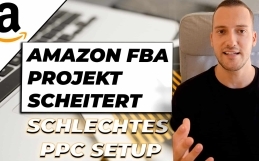Amazon FBA Cost
This is how much your product should cost
Amazon FBA costs & fees are the topic of this Amazon tutorial with Lorenz from eBakery. We break down what costs are involved and deduce how much your product should cost. All this in today’s video.
Amazon FBA Costs - What are the costs and fees?
Amazon fees: what are they? Which relevant? Which ones do we need to pay attention to somehow? How can we actually extrapolate our profit quite well? And what should we avoid in the best case? For this directly into the whiteboard. There are generally relatively many different fees. I will now list the most important ones that are relevant for us. Not only the fees, but also costs that you might want to plan for somewhere. So that means fees and costs. At the very beginning, of course, is usually “purchase price”, that is, purchase price of the product. How much do we pay for the production of our product per piece? That’s one point. Of course, we have to work that out. For brand new distributors you can perhaps still say, if now an order is placed for example for 10,000 € for the production price and we have 1000 products, then of course that would be 10 € per piece. Often, the unit price may not even necessarily be mentioned when ordering. Of course, it is relatively easy to extrapolate based on the number and the total price. Then shipping per piece, which mostly means China to Germany. This means, of course, that we usually produce in China – of course there are also other locations in Asia, for example, or Turkey or Eastern Europe – but let’s just assume that we normally produce in China. China produce and every product must, of course, somehow get from China to Germany, whether by air freight, by ship or by train. And in this, we have various costs coming up. We now assume that we have already prepared everything a bit: we know the shipping price, customs, import and so on, and can also extrapolate per piece how much it cost us to ship to Germany to the Amazon warehouse. That’s important, because now we’ve covered virtually everything in terms of product costs. Partially, of course, there are still merchants who use third-party fulfillment, meaning: some merchants have goods in shipping or preparation centers outside of Amazon, which are prepared there, stored, sent to Amazon or even partially to the end customer. If that were the case, of course, you would have to break it in somewhere.
These are the main costs
The main costs coming from Amazon now.
Here we have the following: Amazon sales fee, this is not the same in every category, so this depends on the category. Quite important in most categories is this 15 percent. I deliberately say most – there are categories where this fee rate is different, it is always calculated on the gross price of the sale, not on the net price. Means 15% sales fee that Amazon takes from the selling price. As I said there is deviation, there is also a special regulation for products under 10 € in part, but we say now “okay, standard product in a “normal categories” over 10 €, which also applies to most products are 15%. Means: we have then on top also FBA fee. To this FBA fee we link times a PDF file of Amazon which is put by the official website quasi broadly. The FBA fee is composed of the following things: the weight of the product and the size, so to speak.
Amazon FBA Costs - The Fee Itself
FBA is, of course, Fulfillment by Amazon. This is all about pick, pack, ship and customer service. Not the return. So, a product in standard size – and we have this table, as I said, that you can look at – we have to look at “Okay, how big is our product? How heavy is our product? “, based on that we can then read in the table how expensive the FBA fee would be, currently this is increasing over the years due to let’s say fuel costs, inflation, other factors on Amazon’s part and the world economy I don’t think that’s ever been looked for, means every year this is getting a bit higher, but unfortunately is also to be expected. FBA fee is quite relevant. The important thing here: this is not dependent on the selling price, not at all. If I have a product in the normal size I say, it does not matter if I sold it for 100 € or for 10 €. The FBA fee, the shipping through Amazon fee, does not change as a result.
The storage costs
Next: storage costs. Here it is now, or storage fee, whatever you want to call it. Each product has its own size and weight, of course. A product now has a certain size and based on that, you can then extrapolate how many cubic meters of volume this product takes away in the warehouse. The storage cost is then calculated on volume, the more volume you use on Amazon, the more expensive it becomes. It is important to note that in the first three quarters of the year, inventory costs are usually lower, and in the fourth quarter, inventory costs are higher. These are billed monthly based on – as I said – what you have in stock, I think is relatively easy to understand. Means: it is recommended to store at Amazon only products that you can get sold relatively quickly. My recommendation would be personal: what I deposit should actually be sold in three months. There are also long-term storage fees at Amazon. Products that are over 12 months at Amazon are charged extra again in the storage fee and very expensive too. To do this, you can also actually look at Amazon, how high that is exactly currently, also changes from time to time. But that is also relevant again. Should hopefully not be an issue for most of you though, as we don’t intend for our product to be on Amazon for 12 months or more. We would like to sell this relatively quickly.
What are the taxes?
Then, another cost item that is not related to Amazon now would be VAT. This is almost all products in Germany at 19%, we are not talking about food at the moment. This goes of course then also from the gross selling price, so it’s then quasi: from the gross 19% down, then we have our net selling price. The value added tax must also be included, but this is usually a current item. Means you can let this start again in part. And a very important point is PPC or marketing. PPC or marketing is a super relevant cost. However, this cannot be predicted exactly. It’s just that it’s extremely account and product dependent. There are accounts where marketing accounts for very little of the revenue, there are accounts where it accounts for a lot. In Germany, with merchants that we look after, or larger accounts that we have access to, it’s the case that we often work towards a target, let’s say, and that’s usually very often between 8% and 10% of total sales. Means, on the total gross sales we would like to spend about 8% to 10% advertising, not more. Less is great, of course, more is not so good. If we now have a 20% profit margin and spend 30% of total sales on advertising, the bottom line is of course that the whole thing is not profitable. Means: extreme differences from account to account, from product to product. A good framework is somewhere around 8% to 10% percent for larger accounts, for newer accounts I say or products that are in the niche area, you could achieve even less.
Total costing
Means now: if we would now consider that we extrapolate the whole time, then we could now simply times überschlagen says: we have a VK gross for example of 100 € and then EK with shipping we can now consider, and the purchase costs with shipping already say times 30 € VAT (value added tax) in the case then quasi about 19 €. Then we have Amazon VK fee, there we can then also say 15 €, FBA fee assumed that is a bit larger product, then we have maybe 10 €, if that would be already relatively large product then actually, and storage costs let’s say per product/per month 1€, you have to then really but extrapolate, if that would now be a very large product, that could be a euro, but is of course specifically also on the product size to see. And then PPC, now that would be all quasi per sale, let’s say we have this 10%, so 10 € total we have to consider 15 euros.
So in that case, if we extrapolate it like this now, we’re at €15. Profit, that would actually already be the actual profit after all relevant costs. Of course, there are still many small extra costs in any company that you might have to factor in. So maybe Amazon has labeled the products, Amazon account fee of 50 € month, one would have to calculate perhaps still with purely, costs for tax advice, and so on and so forth. But for now, it’s about the real Amazon costs that you would have to consider.
Amazon FBA Costs - How much is left on the bottom line?
Now, of course, you can say “okay from 100 € VK only 15 € profits”, of course, then also corresponds to 15% margin in the case. Can you say is not so good now. But you have to take a differentiated view: large Amazon retailers, i.e. the really strong sales have seven figures honestly or more, often have a margin in this range. Many products have about 25% profit before marketing. And the marketing, as I said, again easy 10% cost in many accounts, means 25% profit before marketing, 15% profit after marketing. This shows then also relatively well, at least with so larger accounts that of course by the mass then the profit comes in. In smaller accounts, niche account I say the ones with the smaller niches sell, you can also get more margin out of it, definitely. But is specific from product then again to see. We link as said in the description then the table of Amazon, where you can pick out the fee for FBA, based on size and weight of the product. Otherwise would be to say simply quasi for you a short overview to the fees: there are again surely 50 small other things one with purely can count, above all also in some fees I say times subcategories, which one could consider above all in the dispatch. If the shipping is e.g. 2000 € for a batch of a product, you can of course then again look at “okay, shipping price, costs for the freight forwarder, customs, import, import VAT”, then you can of course break it all down much further. And if you are now, let’s say, in the moment in the project where you want to know very precisely what the profit looks like or the calculation, then I would of course recommend breaking that down very well. Now when it comes to choosing between product, we just want to look at “would this be worth it on the bottom line?”, then the recommendation is just to take the key metrics, so purchase price, shipping price, Amazon fee, Amazon FBA fee, and roughly the marketing costs I’ll say 10% to factor in and then look at “does it make sense on the bottom line?”. The next recommendation is when we sell products should be: before advertising costs definitely somewhere 20% profit there. Products with significantly less than 20% profit before warm costs, are very difficult to sell from experience, simply because we need through the expensive PPC fees or I say PPC costs, somewhere a framework in which we can manage and these PPC fees also perhaps rather through the selling price use and not out of their own pocket quasi finance must permanently. Means: profit margin 20% upwards is good, 25 to 30 is then already very solid, over 30 is great, if that would be feasible. In general, however, below 20% already hard. That on top of that, but we also had an Amazon PPC video talked about it a little bit before, happy to watch that as well.
Amazon agency eBakery
Now you have an overview of the costs that make up the selling price of your products and what the margin is before and after advertising.
The video and the blog serve only as a rough classification. In practice, you then have to weigh things up from product to product and calculate more precisely. If you would like to be supported in this, we as an Amazon agency will be happy to help you. Make an appointment directly here.
Do you have questions or need an individual offer? Do not hesitate to contact us.
- 0/5
- 0 ratings
| Very bad! | Bad | Hmmm | Oke | Good! |
|---|---|---|---|---|
| 0% | 0% | 0% | 0% | 0% |
Haben Sie Fragen oder brauchen ein individuelles Angebot? Zögern Sie nicht, uns zu kontaktieren.



















